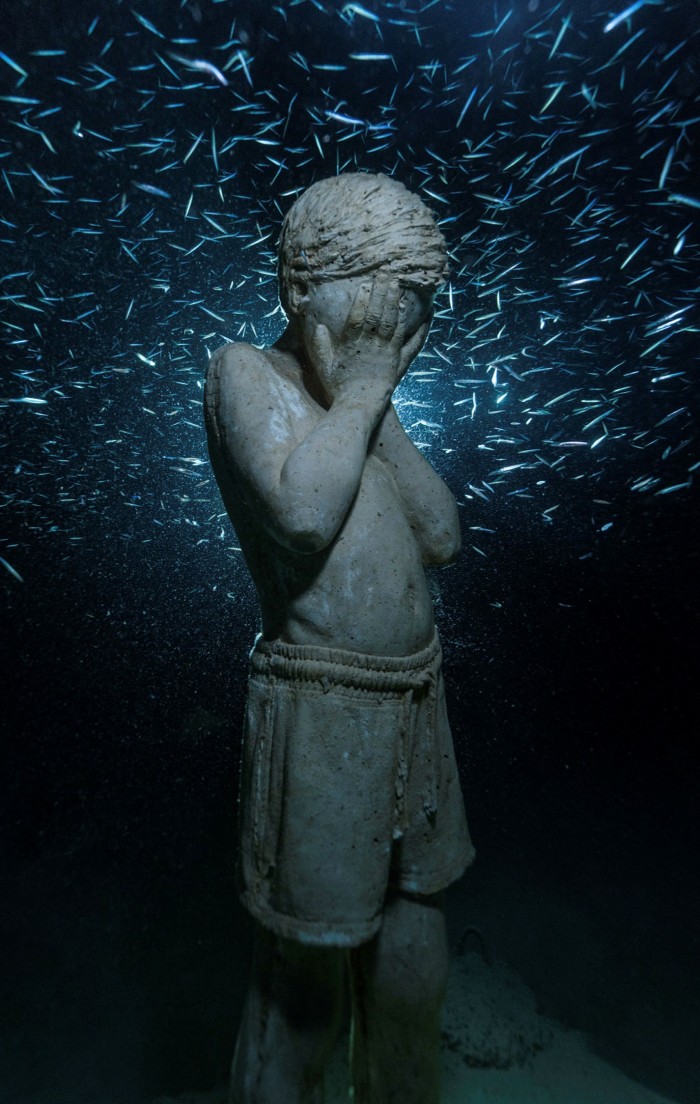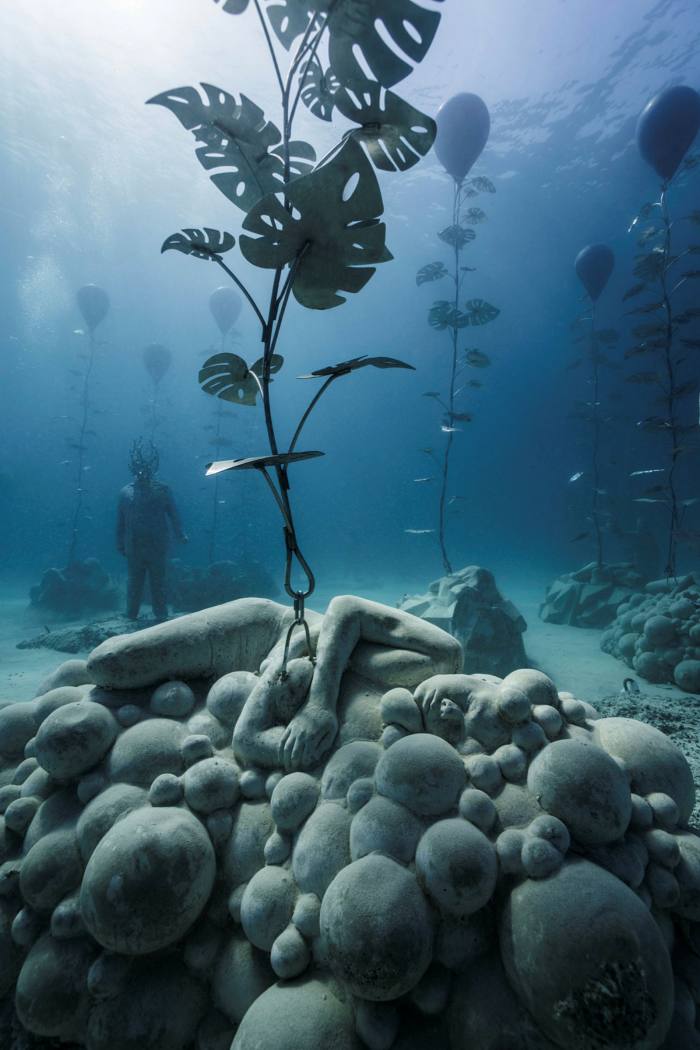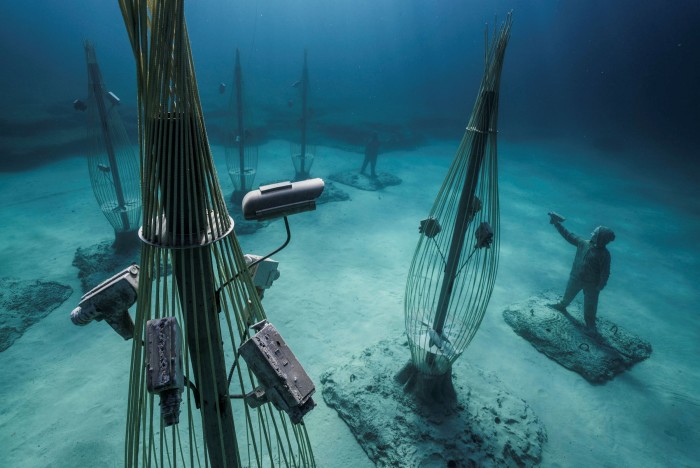
Source: Financial Times
Snacking on the works of art in museums is typically discouraged. But that’s exactly what I’m witnessing at the Museum of Underwater Sculpture Ayia Napa (Musan) as a shoal of flickering fish tuck into the algae on the sculptures’ surface.
This isn’t the only way in which a visit to the newest of Jason deCaires Taylor’s underwater museums, off the coast of Cyprus, is an atypical art experience. The only crowds I have to compete with are cuttlefish flapping around the works. My views of the sculptures are obstructed by the odd swooping freediver. The length of my visit isn’t dictated by how long my legs hold out but by how much oxygen I have left. I’d probably be banned for life if I tried to enter most museums with a back flop.
It feels fitting that this unorthodox museum has an unexpected location: Ayia Napa is less known for its fish than the fishbowl cocktails in its raucous nightclub scene. Yet it’s here, 200 meters from the beach and 8-10 meters below the surface, that the world’s first underwater forest was opened last summer, complete with a seabed ribbon-cutting ceremony and scuba-diving mayor.

© Jason deCaires Taylor
Kicking through its 170-meter length, there’s an immediate familiarity to the leafy foliage of its gargantuan concrete trees, yet also the paradox of seeing a tree under the sea. There’s a sudden sense of being watched. From all sides, the eyes of sculpted figures peer at me. Life-size adults lurk behind trees while children combatively point cameras. All are smooth concrete, realistic yet cartoonish.
It’s a relief to pass a tree and discover that the target of the children’s cameras is a Monopoly-esque industrialist, captured in the process of turning away with an indifferent air. Cameras are a motif deCaires Taylor returns to in his work, reflecting our surveilled world and, perhaps less consciously, his previous job as a paparazzo (part of a string of unusual professions that would make for an outstanding LinkedIn profile). Other child figures have their heads in their hands while some adults simply lie down to die.
The prompt to reflect on our responsibility for nature is clear, the link made explicit by casting the humans in the same materials as the trees. (Some have lost their heads to an explosion of metallic coral.) The style, setting and message of the sculptures combine for an awe-inspiring, unsettling experience.

You could argue that sinking cement sculptures into the sea is not in itself good for nature — cement production alone accounts for 8 percent of global CO2 emissions — but a statement on deCaires Taylor’s website says that “each sculpture is created using non-toxic, pH-neutral marine-grade cement . . . becoming an integral part of the local ecosystem”. Similarly, he plans placement and timing to encourage better human interaction: “In many cases deCaires Taylor’s sculptures are placed away from existing reefs, often in areas of barren sandbanks, to boost diversity, but also to draw tourists away from the delicate ecosystems and fragile corals of existing reefs.”
The sunlight creates a dynamic illumination, while the warping of time and amplifying of silence, the ocean’s own special effects, make this a multidimensional experience. It’s this effect that “got me into this in the first place”, says deCaires Taylor. “They’re not static objects, they’re things that are living and changing and evolving . . . I don’t think anybody can match what the natural world can perform.”
His sculptures are blank canvases for the marine world: they are cast with a textured surface that allows marine organisms, including coral, to attach and grow. Already, some unusual culture vultures have been spotted at Musan: a species of nudibranchs (a marine mollusk) never seen in Cyprus before.
Part of deCaires Taylor’s process is conceiving of inventive ways to attract species specific to the installation’s environment. This is how he arrived at the element of Musan that most mesmerized me: floating balloons tethered by strings to leafy metallic vines. Their suspension has a childish appeal.

© Jason deCaires Taylor
The idea for these came from deCaires Taylor’s lifetime in the water, including a stint as a diving instructor, in which he noticed that “if ever you have floating flotsam and jetsam, it actually attracts a wealth of marine life that hide underneath it for protection”. The range of Musan’s 93 sculptures bears this in mind. “Some [species] live just under the surface, some can come in and out and others are bottom-dwellers, so I wanted to create something that went to all the different tiers. And the only way to achieve that, since it’s not possible to build five-meter structures anchored to the seafloor, was by doing floating pieces.”
One of the biggest challenges is scale. When he was working in Cancún, deCaires Taylor “was making hundreds of sculptures and my studio looked like the Terracotta Army was spilling out of it. It was in the car park, it was in the road, and it was vast . . . And then when I went to install it, it was just this little speck in the vast ocean.” This was also the case for Musan, where in their surroundings the works manage to feel simultaneously colossal and tiny.
This reappraisal of scale is part of what deCaires Taylor intends people to take away from his art. Working on Musan during the pandemic required a rapid repatriation of his global stable of specialists, but more than anything he feels that it “made us aware of how fragile we really are . . . We’re a part of nature ourselves, we’re not apart from it and we’re ultimately at its mercy.”

At Musan, there seems to be symmetry between the new visitors being attracted below the surface and what the people of Ayia Napa hope will happen above it. When I ask the owner of a local hotel about what makes Ayia Napa special, he declares that “it offers something for everyone”. Now that even includes aquatic art aficionados.
































